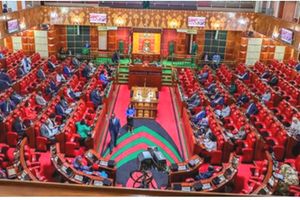
A passenger train at the Nairobi Central Railway Station on November 10, 2020. FILE PHOTO | NMG
Kenya Railways Corporation (KRC) topped the list of State agencies and semi-autonomous entities whose losses crossed the Sh1 billion mark in the year ended June 2023, highlighting their increasing burden on taxpayers.
A Treasury report shows KRC made a loss of Sh33.5 billion in the review period followed by the Roads Annuity Fund at Sh12.8 billion, Kenyatta National Hospital at Sh3.5 billion and Kenya Power Sh3.4 billion.
The report highlights the dire financial state of the majority of the 510 entities which are majority-owned by the State and have turned into a burden to taxpayers amid calls for their privatisation.
Some 22 State-owned agencies posted losses of at least Sh1 billion each in the review period, the report shows. Most of the entities have been relying on bailouts from the Treasury amid the mounting losses, prompting a push to have the State sell off its stake in the firms to private investors.
“We are spending billions of shillings sustaining companies. We have 350 public companies that just take money from the budget and for some of them, we keep asking: what is it that they are doing?,” President William Ruto said last month.
“We need to sell them to the private sector where we will get more value. It is a difficult decision to make but I will take it and face the consequences.”
KRC, Kenya Power, and Kenya Airways are among the entities that have notably been relying on the Treasury for funds to run operations amid struggles to service multi-billion-shilling loans. Bailouts have been covering a substantial portion of budget shortfalls at the entities, with the balance being sourced through borrowing which is either guaranteed or approved by the Treasury.
The Kenya Revenue Authority (KRA) made the seventh biggest loss in the review period at Sh2.48 billion.
Four public universities posted a loss of at least Sh1 billion in the period. Kenyatta University posted a Sh2 billion loss followed by Jomo Kenyatta University of Agriculture and Technology (Sh1.12 billion) and the University of Nairobi (Sh1.05 billion).
Entities whose losses tipped the Sh1 billion mark include Kenya Medical Supplies Authority (Sh3.1 billion), East African Portland Cement Company (Sh2.37 billion), Kenya National Highways Authority (Sh2.9 billion) and the National Transport Safety Authority (Sh2.33 billion).
However, 16 entities did not report their financial performance in the review period, up from 11 in the financial year that ended June 2022, highlighting a casual approach to accountability of public funds.
A combination of lack of revenue diversification and poor management have been blamed for the soaring losses at the State-owned corporations and semi-autonomous agencies.
Dr Ruto has since last year aggressively pushed for the sale of several non-strategic and poorly performing public entities.
In October, the President signed into law the Privatisation Act 2023 that appears to give the administration powers to sell off entities without seeking parliamentary approval.
Out of the 510 entities, 16, including the Kenya Broadcasting Corporation (KBC), are insolvent. The KBC’s liabilities outstripped assets by Sh76.56 billion in the review period followed by KRC at Sh71.69 billion.
Those that are technically insolvent include Muhoroni Sugar Company whose liabilities outgrew assets by Sh37.4 billion followed by Miwani Sugar Company (Sh21.1 billion), Agro-Chemical and Food Company (Sh7.36 billion) and Egerton University (Sh2.46 billion).
Surplus cash by the entities grew 36.7 percent to Sh196.4 billion in the period, underscoring why Treasury and Parliament have in recent years ramped up efforts to have the cash surrendered to the Exchequer.
Parliament last year ordered for a fresh audit of cash surpluses State corporations.
Surplus cash is comparable to profits by the State-owned entities and represents the balance between their revenues and expenses after tax.







